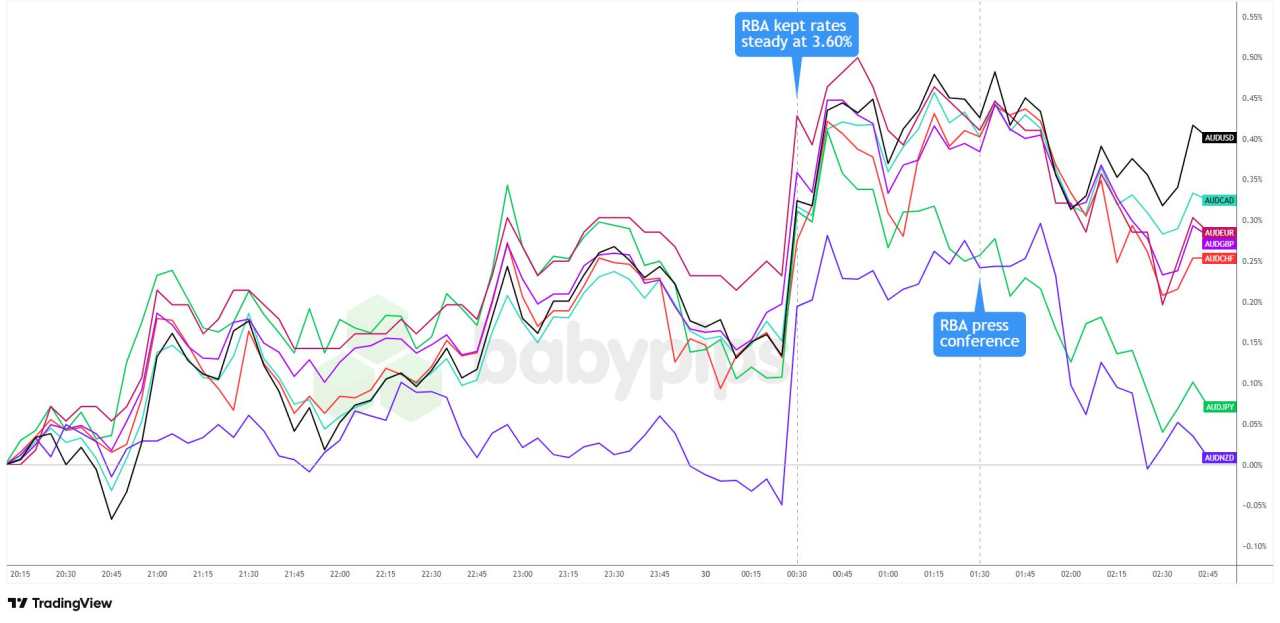The Reserve Bank of Australia (RBA) kept the cash rate unchanged at 3.60% in September, in a widely anticipated decision that reflected the central bank’s cautious approach amid mixed economic signals.
The unanimous vote to hold came as recent data suggested inflation might be proving stickier than expected.
The RBA struck a cautious tone, noting that “recent data, while partial and volatile, suggest that inflation in the September quarter may be higher than expected.”
The board emphasized it would remain data-dependent, stating it was “appropriate to remain cautious, updating its view of the outlook as the data evolve.”
Key Takeaways:
- RBA held at 3.60% following three cuts in 2025 (February, May, August)
- The decision was unanimous among board members
- August monthly CPI jumped to 3.0% y/y from 2.8%, the highest since July 2024
- Q3 inflation “may be higher than expected”
- Private consumption picking up as real incomes rise
- Housing market strengthening from the rate cut effects
- Credit growth accelerating to 7.2% annually
- Unemployment steady at 4.2% in August
Link to the official RBA Monetary Policy Statement for September 2025
The central bank warned that “indications that inflation may be persistent in some areas” justified holding steady. Governor Bullock emphasized the need to see the full effects of this year’s 75 basis points of easing before moving again.In her press conference, Bullock stressed that “we’re in a very difficult position with the property market” but emphasized the RBA must focus on its inflation mandate. She warned that higher prices “affect everyone” and reiterated that lowering inflation doesn’t mean deflation – “we’re lowering the rate at which prices are increasing.”
Bullock refused to provide forward guidance, stating, “I’m not going to predict what the interest rate is going to be in the next three to six months.”
Markets had widely expected the hold. NAB now sees no cut until May 2026, while Westpac maintains its November forecast.
Link to RBA Press Conference for September 2025
Market Reaction:
Australian Dollar vs. Major Currencies: 5-min

Overlay of AUD vs. Major Currencies Chart by TradingView
The Australian dollar, which had been leaning bullish since the Hong Kong and China market open, jumped broadly and sharply at the RBA’s hold decision as traders scaled back easing expectations.
The immediate gains likely reflected reduced odds of a near-term rate cut after the RBA highlighted upside inflation risks and improving domestic demand. With the central bank signaling it wants to see the full Q3 CPI report before moving again, markets pushed back expectations for the next cut from September to November or later.The currency then pulled back during Bullock’s press conference, as the RBA chief reiterated the bank’s “cautious, gradual” approach.
AUD’s dip after Bullock’s presser likely reflected disappointment that she downplayed inflation risks, saying “inflation is not running away” and calling the outlook “quite positive” rather than pushing back against rate cut expectations.
Her refusal to provide forward guidance, while pointing to global uncertainties and the need for more data, was taken as leaving the door open for further easing if conditions soften, which dented the currency’s yield appeal.
End-of-quarter flows may have also played a part, especially after the Aussie’s broad gains late last week.
The currency remains in the green, with the biggest gains against USD, CAD, and CHF.


加载失败()